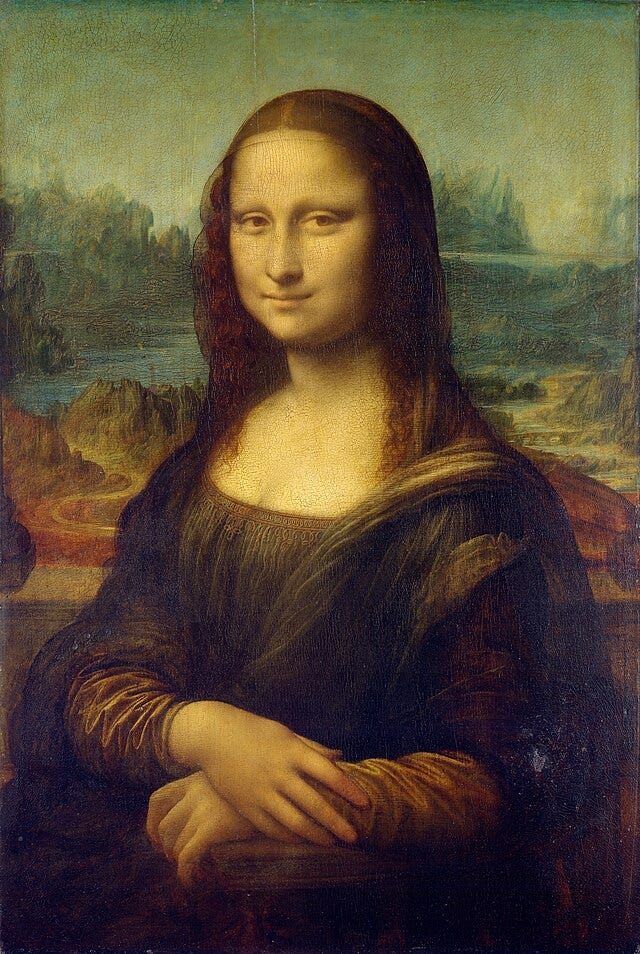Unveiling the Mysterious Smile: Decoding the Mona Lisa's "Mewing" Expression
Dive into a unique theory suggesting that Leonardo da Vinci's masterpiece, the Mona Lisa, may have been portraying a mewing expression to showcase anatomical details of jaw muscles and bone structure.
I have a theory that the Mona Lisa is "mewing" because Leonardo da Vinci intended to depict the muscle and bone structure of the jaw. What I am suggesting is a unique perspective on this iconic painting. To expand on this idea, first let’s delve deeper into the concept of mewing itself and its relevance to facial anatomy.
Mewing is a term popularized by Dr. John Mew, an orthodontist who proposed that proper tongue posture against the roof of the mouth can influence facial development and alignment of teeth and jaws. This technique aims to improve overall facial aesthetics by promoting correct oral posture.
When applying this concept to the Mona Lisa, I can only imagine how how da Vinci might have been ahead of his time in understanding or depicting principles related to facial harmony and structure. By emphasizing these elements in the Mona Lisa’s expression, de Vinci may have subtly hinted at underlying anatomical features like jaw muscles or skeletal contours through her enigmatic smile. Discovering how Leonardo da Vinci might have incorporated an understanding of facial anatomy in his iconic painting, shedding light on the possibility of the Mona Lisa exhibiting mewing characteristics.
da Vinci's expertise as both an artist and a scientist allowed him to incorporate detailed anatomical observations into his works. By studying cadavers and dissecting bodies during his time, he gained unparalleled insights into human anatomy that undoubtedly influenced his artistic representations.
By weaving together historical context with modern theories such as mewing, your article can offer readers a fresh perspective on one of art history's most enigmatic masterpieces; I invite you to see the Mona Lisa in a new light through the lens of facial anatomy and artistic innovation.
My theory about the painting showcasing the muscle and bone structure under the jaw through a concept like "mewing" is quite intriguing.
To expand on this idea, you could delve deeper into how mewing - which involves proper tongue posture against the roof of the mouth to potentially improve facial structure over time - may have influenced Da Vinci's portrayal of the subject in his artwork. Consider exploring historical contexts, anatomical studies available during Da Vinci's time, and any potential links between mewing principles and artistic representations.
Additionally, you may want to discuss how your personal experience with mewing as a 5/1 Manifestor has impacted your own facial structure. Sharing anecdotes or scientific insights related to this transformation could further strengthen your argument regarding its possible relevance to artworks like the Mona Lisa.
By combining art history, anatomy, personal testimony, and relevant research findings, you can create an engaging article that presents your theory effectively while offering readers valuable insights into both mewing practices and artistic interpretations from different perspectives.
In exploring the theory that Leonardo da Vinci may have depicted the Mona Lisa with a mewing expression to showcase anatomical details, we can delve into his deep understanding of human anatomy. Da Vinci was not only a renowned artist but also a keen observer and scholar of the human body. His meticulous study of anatomy allowed him to accurately portray the intricacies of muscles, bones, and facial expressions in his artworks.
Considering this perspective, it is plausible to suggest that da Vinci could have been intentional in depicting subtle nuances related to muscle and bone structure in the Mona Lisa's face. Mewing as a concept involves proper tongue posture against the palate, which some believe can influence facial development over time by potentially affecting jaw alignment and muscle tone.
By inferring that da Vinci might have incorporated elements akin to mewing into his portrayal of the Mona Lisa, one could argue that he sought to convey not just her enigmatic smile but also underlying anatomical features such as jaw positioning or muscular engagement. This interpretation adds another layer of complexity to an already captivating masterpiece, inviting viewers to contemplate both aesthetic beauty and physiological accuracy in art.
Exploring how da Vinci's attention to detail extended beyond surface appearances to include considerations of anatomical placement further enriches our appreciation for his work and opens up intriguing avenues for interpreting iconic paintings like the Mona Lisa from fresh perspectives.
Did da Vinci intend to depict underlying muscle and bone structures through his renowned portrait? Was the Mona Lisa mewing?
Listen to the podcast episode HERE




